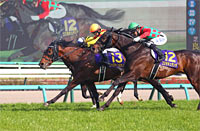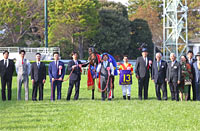2015 News
Data Analysis for the “2015 Satsuki Sho (Japanese 2000 Guineas) (G1)”A gathering of elite 3-year-olds with their sights on the Triple Crown Racing fans must be champing at the bit as we approach the Satsuki Sho, the first classic in this year’s Triple Crown. After all, only the winner of this race can still dare to dream of taking the Triple Crown. So this time, let’s uncover some notable trends in this race from results over the last 10 years (including 2011, when it was held on the 2,000m turf course at Tokyo, in the wake of the Great East Japan Earthquake). Check favoritism in the debut race If we check aggregate performances over the last 10 years based on the runners’ favoritism in their very first race, we find that 29 of the 30 top 3 finishers had been backed within the top 5 to win that race. Although there is no great difference between the “1st favorite”, “2nd favorite” and “3rd-5th favorite” in terms of the top 2 ratio, horses with a debut backing as “1st favorite” are well ahead in the top 3 ratio. By contrast, those slated as “6th favorite or lower” on their debut have produced only one top 3 finish (2006 runner-up Dream Passport). The likelihood of success seems to rise with the level of favoritism enjoyed in the debut race. [Table 1] [Table 1] Performance by favoritism in debut race (last 10 years)
Winners of previous race dominate Turning next to the runners’ performance by their finish in the previous race, we find that 9 of the last 10 winners had also finished “1st” last time out. And although 13 horses finishing “2nd or lower” in their previous race have occupied 2nd or 3rd place in the Satsuki Sho, winners of the previous race have better success ratios than those beaten to 2nd or lower. What’s more, no horse finishing “10th or lower” last time out has made it into the top 3 here. So first of all, we should focus on runners coming straight from a victory in their most recent race. [Table 2] [Table 2] Performance by finish in previous race (last 10 years)
Check the turf graded race record within the last three outings A look at the runners’ performance by their recent race record shows that, over the last 10 years, 23 horses with a highest finish of “1st” in turf graded races within their last three outings have finished in the top 3 here (including 9 winners). If we include horses finishing “2nd” in those races, we find that all 10 winners, 18 of the 20 top 2 finishers, and 27 of the 30 top 3 finishers had previously experienced a top 2 finish in turf graded races within their last three outings. On this big occasion of a classic race contested by the best 3-year-old horses, it seems difficult to achieve success without experiencing a top 2 finish in turf graded races within recent outings. [Table 3] [Table 3] Performance by highest finish in turf graded races within the last 3 outings (last 10 years)
Look for runners with no big defeats recently To organize performances by the runners’ lowest finish in their last three races, horses coming to this race with a lowest finish of “1st” in that time – in other words, with nothing but wins – have amassed an impressive top 3 ratio of 53.3% over the last 10 years. Of the others, success ratios diverge greatly between those with lowest finishes of “2nd-4th” and “5th or lower”, respectively. Specifically, horses with experience of finishing “5th or lower” in their last 3 races have had hardly any success in the Satsuki Sho. Runners with this kind of form seem unlikely to break into the higher places in this race. [Table 4] [Table 4] Performance by lowest finish in the last three races (last 10 years)
Seek out the winners! Comparing the runners’ two most recent races in terms of favoritism, all six winners since 2009 were either backed as “1st favorite in both races” or had “higher win favoritism in the previous race compared to the one before”. This year, too, our attention should be on horses backed as 1st favorite in their previous two outings, or with higher favoritism in their previous race compared to the one before it. [Table 5] [Table 5] Winners’ favoritism in the previous two races (last 6 years)
(Data analysis by Michio Kawano) |

|



















